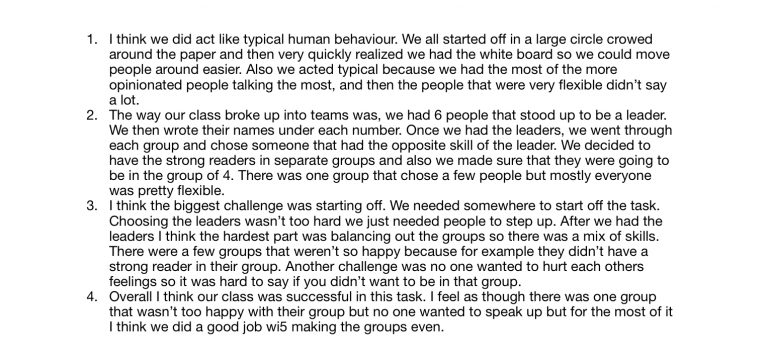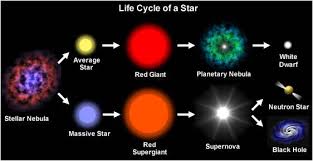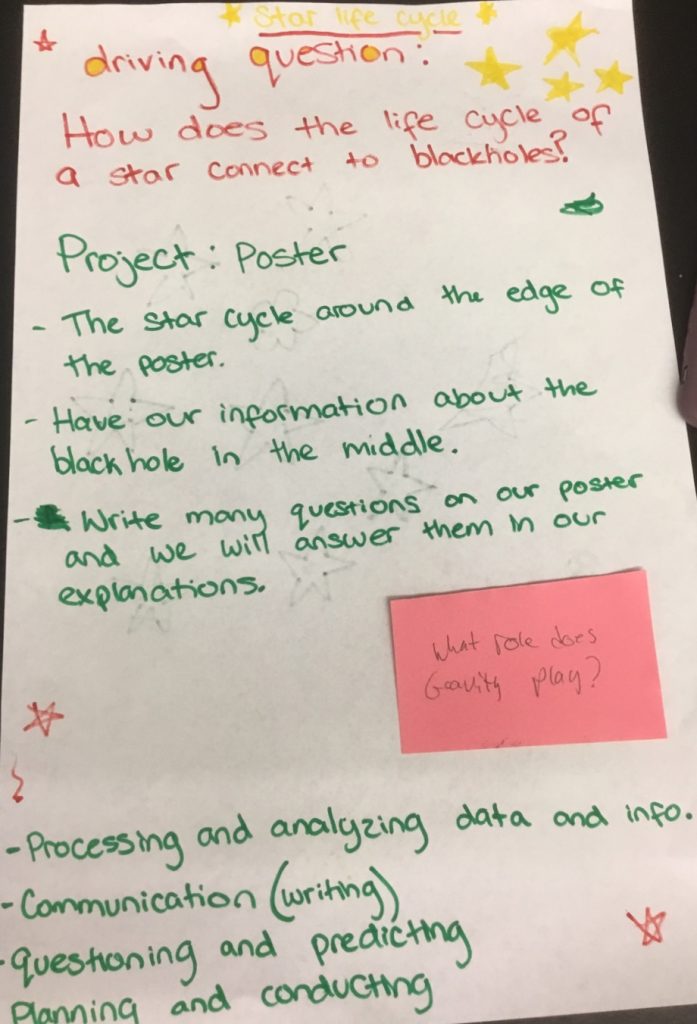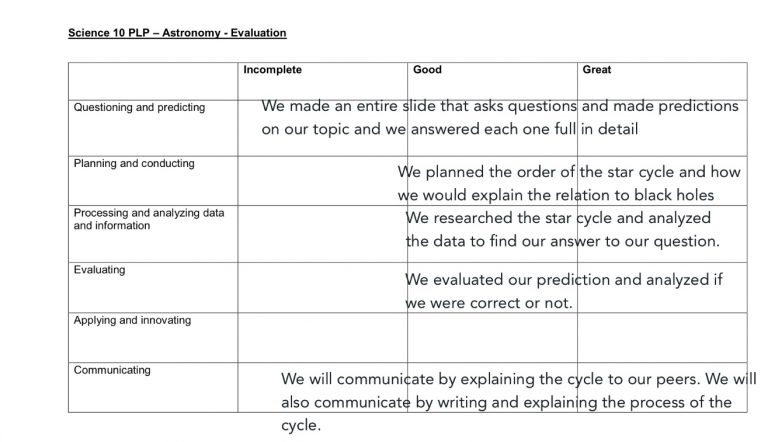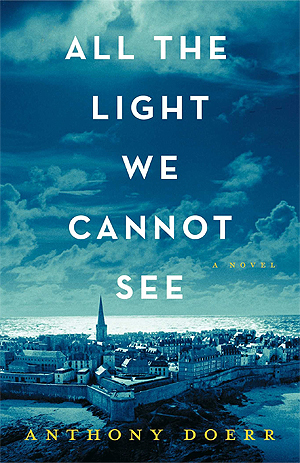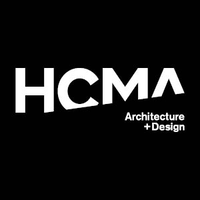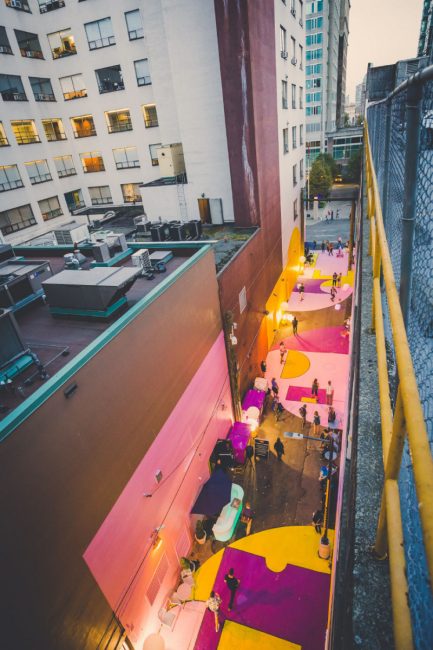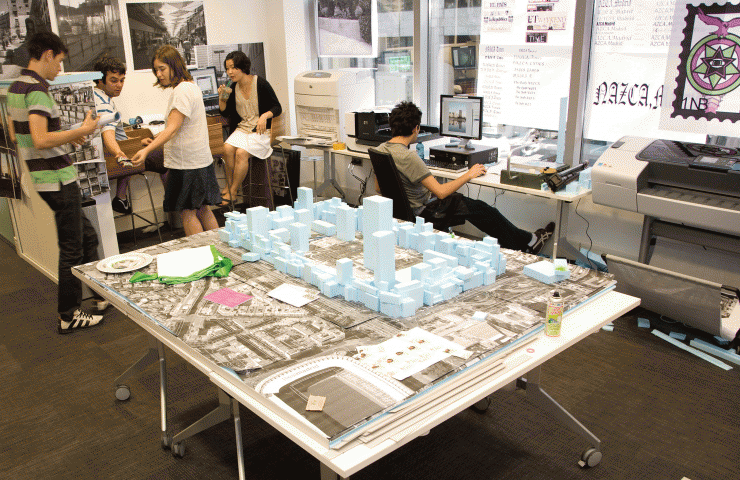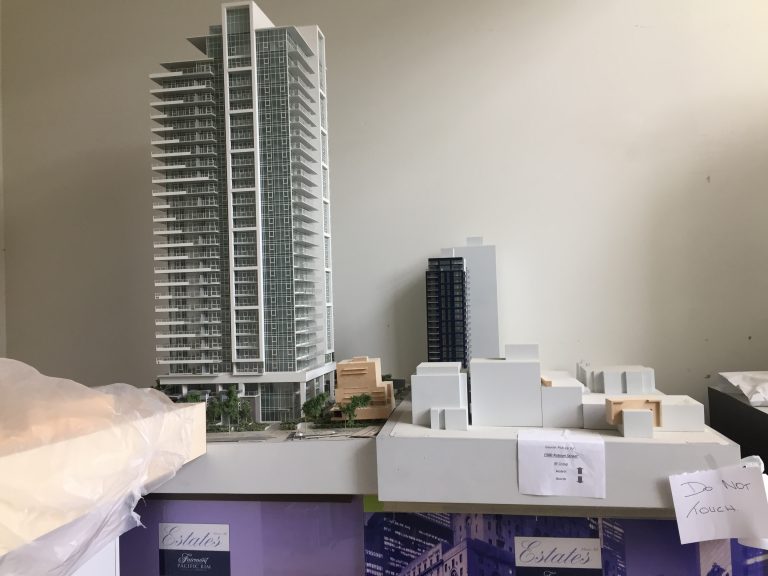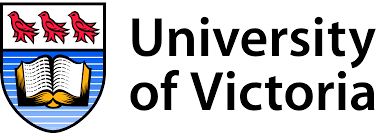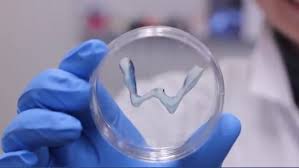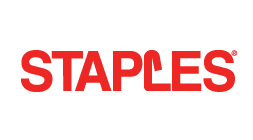To wrap up our final unit in humanities, unlike learning about the wars our topic was government and democracy. This is from novel studies, to participating in a class debate. This whole unit was around the idea of formulating opinions, communicating and speaking skills. Like always we had a driving question for this unit, “how do we organize ourselves?”. A huge part of this answer has to do with the novel we read, Lord Of the Flies by William Golding.
A lot of this unit was teamwork and throughout the unit we were going to be working in groups. The very first task our class was given was to sort our selves into groups. This may sound easy, however trust me it was harder than you would think. Basically our teacher left our class alone in a room and we were told to make six groups of four or five. There was a catch, in the groups there had to be a different variety of skills. You also couldn’t just make a group with your friends. This was a pretty chaotic experience.
Reflection:
With the groups we had created, they were going to act like our islands. My group was Will, Adam, Ryan and I. In these groups we were going to be working as a team to earn points. This unit was sort of like a competition. Every team could lose points and gain points. At the end the points would be tallied up and the winning team won a prize.
This challenge was a social experiment to see how our class would react in certain situations. The challenge related Lord Of the Flies, we were introduced to this novel early on in the unit. Lord Of the Flies is a common novel study in schools and is all about human nature. We had around one month to finish the book. Wednesday was kind of our check in day, we were assigned around five chapters each week and we also had our team quizzes. The team quizzes were done with our islands (groups). The questions were all about the novel and the chapters that were assigned that week. The team quizzes were also an opportunity to lose or gain points. You could lose points if you failed and you could gain points if you scored 100%. Unfortunately our team never got 100% however, there was growth shown from the first quiz (6.5/10) to the last where we got 9/10.
I’ll do a quick review on the book. Overall I really enjoyed the book. It was very interesting about what the boys instincts were when trapped on an island. Also it was interesting because the way the boys acted, is probably how our class would have acted if we were stranded on an island (maybe not to the extreme). What we found is that the way they acted is human nature.
Though out the novel, we were filling character analysis charts. This is so we could show our understanding of the book, evidence that we actually read the book. On the chart we had to give descriptions on the main characters and their role in the book etc.
Also in the book there were specific symbols. For example the conch that represents leader ship. There were certain objects that represented something. We also filled out a symbols sheet talking all about the symbols in the book and what they mean.
Politics!
Something I learned is that politics are pretty important, knowing the voting system, governments and even current events, such as the Kinder Morgan Pipeline.
We learned about the Electoral System (very confusing). In groups we were given a system we had to try and explain. Canada has the most simple system luckily called Pass the Post. I was in the group that had to figure out the Mixed Member proportional system. This was definitely the most confusing! Honesty I still don’t really know how it works. They use this system in Germany and New Zealand.
We also learned about the different types of government. We created a diagram to get an idea for Who’s Who. I definitely learned a lot from making this chart, before I didn’t know for example I now know that the lieutenant governor is, a Janet Austin.
Something our whole class did, was take a quiz on the Political Spectrum to see where you lie with political beliefs which was pretty fun! I learned a lot about the rest of the class and where they stand on the Political System.
We also studied the Role Of the Charter. This is a document that explains your rights and freedoms. Here are four of the rights and Constitutional guarantees, democracy, rule of law, freedom and minority rights. Something I learned from this is if you get caught by the police, and they want to arrest you, you have to right to ask why you are being arrested.
Something that was a huge aspect of this unit was the debate. We were told at the beginning that eventually everyone would participate in a class debate. This was going to be our final assessment for our unit of Lord Of the Flies. A piece of information our teacher gave us was, that being able to public speak is the most important skill. This is something that I am not a fan of however, I knew this unit would be good practice for me.
An activity we did to practice formulating an argument, was to write a concept journal. Another reason we wrote these was because for the debate we needed to use evidence from previous humanities studies we had done this year. Basically for the concept journal there were several topics, for example power and authority, human nature, individualism and community, etc. Within those topics the class brain stormed things we had done within each category. For example WWII would go under the category of power and authority.
We were going to be writing two concept journals. I chose to write my first one about High Tech High, which is under the category of community and individualism. I chose HTH because I thought it was a good example of a community. We visited HTH when we went on our field study to California. To start our concept journal we had to either have an inquiry question or a statement. In my journal I had to use find examples as evidence of why HTH is a example of a community and individualism.
My favorite journal:
Like I said we wrote two journals, however this one was the journal I was most proud of.
Anyways, back to the debate…
We did many activities leading up to the debate to develop speaking skills.
A key part of debating is being able to think on your feet. An activity our class did to practice this skill, was called pass the buck. Like Lord Of the Flies, the buck represented the conch. Whoever was holding it, was the only one who spoke. We did this activity in our island groups. One member from each group would volunteer and they were secretly given a topic (ex. Bubble gum). They would then come back to the group and start talking about that topic. When our teacher said pass the buck the next group member would carry on what the first member was saying. This was a good activity because it got you thinking on your feet and you had to communicate with each other in order to know what the topic was.
An activity similar we did was impromptu speeches. Basically one person would stand in front of the class and you were given a very simple question. You had 30sec-1min to answer the question. In the end only two class mates went and our teacher also tried it.
The Great Debate….
For this debate we had been preparing for, we were given our topic a week before so we had plenty of time to prepare. My group was given Power and Authority. The way our teacher picked them, was each team said their top three choices and pretty much everyone got theirs. Obviously with a debate there are two sides. To decided the sides we flipped a coin. Luckily our group got PRO.
Our statement: Be it resolved that power leads to corruption
I was happy with our argument because since our evidence had to be from a topic we had learned about we could talk about the leaders Mussolini and Hitler. Another rule for the debate was you have to mention Lord Of the Flies and use evidence from the novel. Every group created a Google Doc with their team and filled in a chart that you could use for possible evidence.
In our own time we were assigned to listen to a Intelligence 2 Debate podcast to get a feel of what the layout is for a debate.
Here is the layout we decided on:
– Introductions: 2-3 minutes
– Hosts, Topics, Teams
– Opening Statements: 2 minutes each side, PRO, CON
– Rebuttal: 2 minutes each side, PRO, CON
– Question from judge or audience: 1 minute each side, PRO, CON
– Concluding statements: 1 minute each side PRO, CON
We also had to decide who was going on what day. Our group went first. I was pretty happy about this because I was already pretty nervous so it would be good to get it done!
Before the debate I was pretty nervous the video we watched about the secrets to public speaking helped. The tip that stood out to me was think of the debate as a conversation. Going into the debate I knew what I was say. Me and Adam talked about politics and Ryan and Will talked about LOFT.
Our debate went pretty good. Our result was to be revised however I think we did a pretty good job with the rest of the debate and especially since we went first and did really know what to expect. We lost, however it was very close!p, it was 6-7!! I think the rebuttals was the biggest issue. Since we went first, this was learning for the other teams for the next debates. That was something we changed, the rebuttals were slightly different layouts. It was definitely a learning experience. For the last two debates everyone was a lot more enthusiastic and knew what they were doing.
Since we are in PLP, of coarse we recorded the debates. Check out our podcast (debate)!!!
Also go check out the other two debates our class made. Thanks to Sam, Aiden and Isobel for editing them!
Overall this was definitely a fun unit. Out of all the other units, I almost found this the most challenging. Mainly because I’m not a fan of public speaking. This unit took me out of my comfort zone and especially after the debate I feel like I am a lot more confident with speaking in front of an audience. Not only did I improve my speaking skills but I also learned a lot about politics and how governments work. I think Lord Of the Flies is definitely the best school novel I have read! All in all, I think this is the unit that has benefited me as a person the most!



